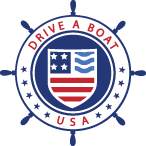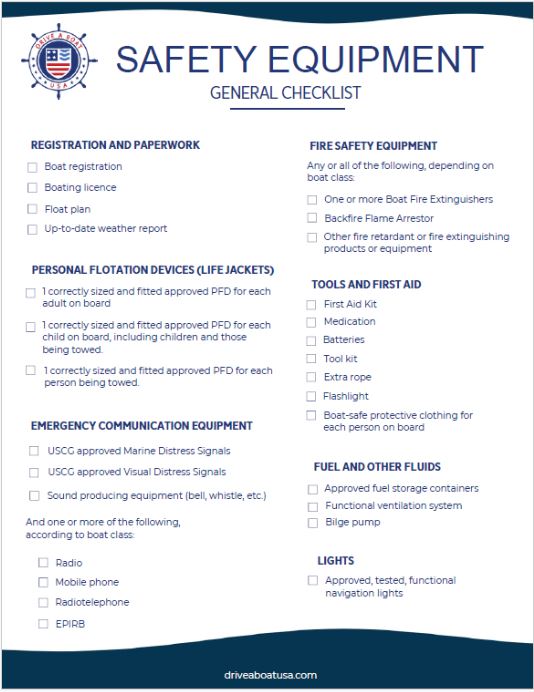Complete Boat Safety Equipment Checklist
Are you ready to leave the dock? Check once, check twice, and check again. You can’t be too careful about boating safety. If you want to be certain you haven’t missed anything, refer to the complete boating safety equipment checklist from Drive A Boat USA.
Keep reading for more details, or you can download our checklist in printable PFD format: Drive-A-Boat-USA-Equipment-Checklist
Note: Legal requirements for boating safety equipment vary according to state and to the size of your boat. Some items must be approved by the USCG to meet safety standards. Requirements will also vary according to the size and type of boat, and to the comfort level and experience of the captain and crew. All items must be in good working condition.
Boating safety equipment
The following is an example of the minimum safety equipment you should have on board. Remember to load your equipment on your boat away from the boat launch area and always double-check that your equipment is in good condition and functioning properly before heading out.
Registration and Paperwork
Boat Registration: Keep your boat registration and any other documentation related to boat ownership on hand, and confirm that your registration number is displayed correctly on the hull.
Boating Licence: Keep your state-approved boating licence with you at all times while out on the water.
Float Plan: Always file a float plan in person, via SMS or by email before heading out. You can’t file a float plan with the USCG.
Weather report including any advisories: Collect all relevant, up-to-date information about weather reports and any warnings, such as Small Craft Advisories, and make sure you have easy access to them in paper or digital format.
Personal Flotation Devices (Life Jackets)
The USCG enforces the use of PFDs while on board a boat. You must have a suitable PFD for each person on board, including children and those being towed. These must be the right size and type for the person and the activity, and they must be worn at all times.
Some state laws may differ. Always check regulations according to the size and type of boat you are using, and remember that inflatable PFDs are not approved for all boating activities.
Emergency Communication Equipment
You are legally obliged to have on board the appropriate Marine Distress Signals, including Visual Distress Signals and sound producing equipment (bell or whistle), for your size and type of boat.
You also need at least one other communication device, such as a radio, mobile phone, VHF Radiotelephone or EPIRB.
Fire Safety Equipment
The USCG stipulates that all boaters must carry appropriate fire safety equipment. Depending on the size and type of boat, this will include a Boat Fire Extinguisher and Backfire Flame Arrestor.
Tools and First Aid
First Aid: Purchase a new first aid kit and keep it within easy access. Be sure to leave the dock with any medication needed by the captain or crew, and note the affected persons’ medical conditions in your float plan.
It is always a good idea to carry basic tools and first aid gear with you on board. Keep some extra batteries on hand, and bring a tool kit long with the right tools for the appliances on your boat. Extra rope and a flashlight always come in handy.
Fuel and Other Fluids
Fuel storage: Store your fuel in an approved container far from any heat sources, flames or sparks.
Gasoline fumes: Make sure your engine ventilation system works before you leave the dock, and as part of your regular boat maintenance.
Bilge pump: Confirm that your bilge pump is working properly before you head out.
Lights
Verify that you have installed the right boat navigation lights for your boat type and that they are functioning correctly before you leave the dock.
Stay safe with a boating license from Drive a Boat USA!
Using a checklist only takes a few minutes, but it could save you hours of trouble and prevent serious boating catastrophes. It’s worth the effort!
Remember, whether you’re boating in New York, California, Florida or elsewhere in the US, you can get licensed with Drive a Boat USA.


